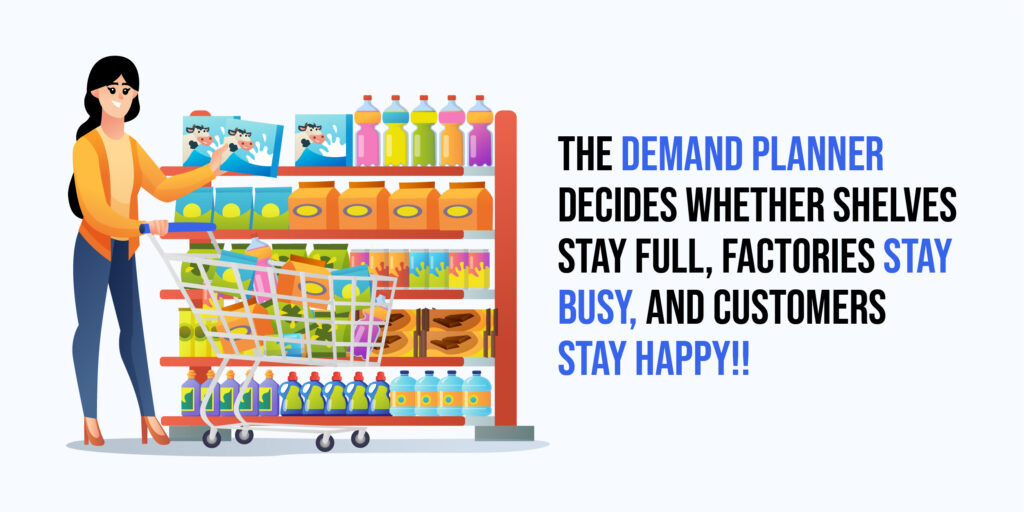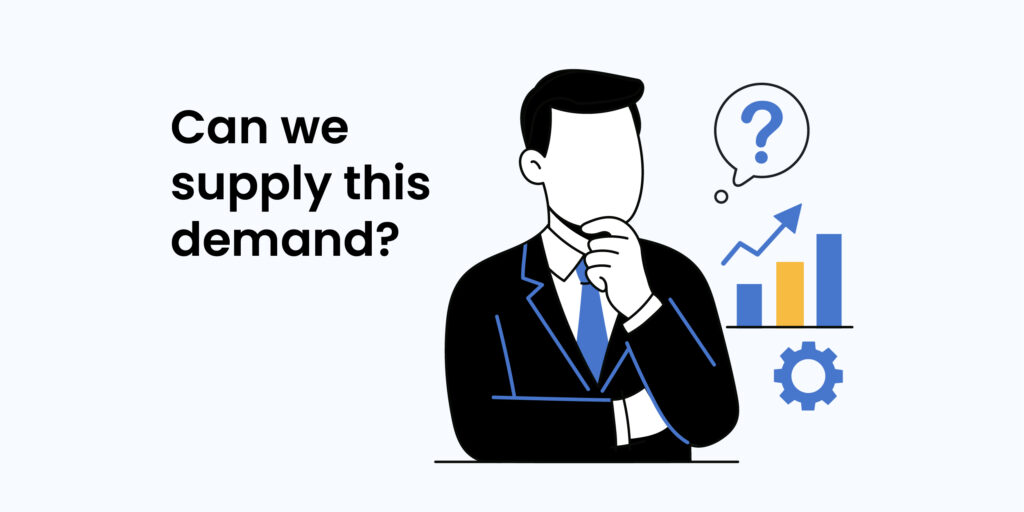When demand and supply planning fall out of sync, the whole chain suffers. That’s why it is important to understand the different yet interdependent roles.
If you’ve ever wondered where demand planning ends and supply chain planning begins, you’re not alone. Even within Fortune 500 operations, the boundary between these two critical functions often blurs, and that confusion can have consequences (often financial, too).
The following guide will help you understand:
-demand and supply planning roles
-why getting this balance right matters not just for operations, but for finance as well.
Let’s get started.
Understanding Demand Planning
In demand planning, the demand planner will forecast how much a product will be sold in the coming period. He predicts what customers will want, when they’ll want it, and how much. This helps the organization deliver efficiently and profitably.
Let’s consider this with the help of a simplified example:
Lisa wants to set up a cupcake stand outside her house. Before she sets up her cupcake stand, she will estimate how many cup cakes does she expects to sell in a single day.
Lisa must consider factors such as, what day of the week it is (perhaps more cupcakes are sold during the weekend), or what weather it is likely to be (perhaps people don’t go out to buy cupcakes in a rainy weather) etc.
All these factors will make up a forecast amount of the number of cupcakes she plans to sell and how much revenue she expects to generate.
A demand planner works in a similar way. However, he will be responsible for many more SKUs* and markets with complex demand patterns. Demand planning is important as over/under forecasting errors can have costs and sales of a company.
Note SKU* stands for stock keeping unit and you might have noticed different products having particular SKUs. Each SKU defines a particular product. For instance, a blue medium size t-shirt will have an SKU as TS-BLU-M.

Factors That Influence a Demand Forecast
The role of a demand planner is to create forecasts based on subjective inputs. Usually, people assume that a demand planner will take historical data and add/deduct some percentage from it for the following period. However, there are many factors that influence future demand plans.
Here are some examples of factors that can influence forecasts:
Environmental factors
A road re-pavement near a restaurant, for instance, can affect the nearby traffic flow . Fewer people may pass by the restaurant, as a result. The demand forecast will include this factor in its forecast when considering the number of customer visits (and potential change in sales).
Promotions
The sales team plans a promotion, so the demand planner will adjust his forecast based on this input.
How Demand Planning and Supply Chain Planning Work Together
Both demand planning and supply planning teams run on a monthly cycle. Once the demand planner forecasts independently. He shares his forecasts with the sales and customer services team.
The sales team has sales data about what products or orders they are expecting. The sales team lives closest to the customer, who hears what’s being promised, what’s being delayed, and what’s changing. They bring their own information regarding the real-time knowledge of expected orders, delivery schedules, and timing.
Now there’s a conversation.
Sometimes the sales team agrees. Sometimes they don’t. They might say that a particular product is going to spike due to XYZ factors or a certain region cooling down.
The demand planner will incorporate those suggestions (or may choose to disagree). This may involve doing some data processing* of the sales data/insights and getting the results.
Data processing* is taking raw data (like numbers, survey results, or logs) and cleaning, organizing, or transforming it so you can understand or use it more easily.
Once the forecast has been amended according to the sales teams’ insights, the demand planner will upload the final demand forecast into Oracle. At this point, the rest of the demand planning team may review the forecast and approve it.
After this, the forecast flows down to the supply chain planning team.
The supply planners take the demand forecast as an input and focuses on making sure the company can meet that demand efficiently. That includes production schedules, inventory levels, procurement of raw materials, and logistics.

The supply chain planning team looks at the forecasts and the reality. The reality being factory capacities, material availability, logistics, labor, and cash. This step is called the demand review.
Once that check is done, the process moves into reconciliation, the pre-S&OP meeting. Think of this as the company’s internal alignment before the big stage. Here, data from every corner, demand, supply, portfolio, finance, gets consolidated into one story about what’s really happening in the market.
Finance usually leads the pre-S&OP meetings. They’re the ones ensuring the numbers align with business targets. They ask tough questions such as whether they can afford the given plan or is the level of inventory sustainable? Will we be able to meet our financial targets?
After this pre-S&OP alignment, the story rises to the top, the executive S&OP meeting, led by the company’s executives.
The Role of S&OP in Business Planning
In the executives S&OP meeting, a plan is created that integrates customer demand, operational capacity, and financial goals. The purpose is to ensure that the company is not overproducing, understocking, or misallocating resources.
Hence, in this meeting, decisions are made. Trade-offs are agreed upon. The future, in a sense, is signed off.
But what exactly is discussed in the S&OP meeting?
What is discussed in the S&OP meeting?
The aim of the S&OP meeting is to show the whole picture to the executive and agree on a single course of action to meet the business goals.
In the meetings, all the plans and data are pulled from the demand and supply planning teams, including bookings, shipments, backlog, production plan, and inventory details.
Each team presents its perspective. The demand planning team will share the demand outlook while the supply chain team will show the supply capabilities.
There can be several things discussed in the meeting, such as comparison of forecasts with the supply chain capability. Questions such as will the forecasts help achieve the financial goals of the company? Or can we keep up with the demand that comes with a promotion?
Since several functions are involved, there can be differences or disagreements between the functions. For instance, the supply chain team controls inventory. Inventory often ties up the biggest amount of the company’s cash. Guess who may not like this? The finance team.
Learn more about the cross-functional alignment in supply chain planning here.
The 5 Typical Steps of the S&OP Process
| Step | Description | Who’s Involved |
| 1. Data Gathering | Collect data on sales, forecasts, inventory, production, and finance. | Demand planners, supply chain, finance |
| 2. Demand Planning | Create and validate the demand forecast based on sales trends, promotions, and market data. | Sales, marketing, finance |
| 3. Supply Planning | Assess supply capabilities (production, procurement, logistics) to meet forecasted demand. | Operations, procurement, manufacturing |
| 4. Reconciliation | Compare demand and supply plans; identify gaps, constraints, or imbalances. | Cross-functional team |
| 5. Executive Review | Leadership approves the final plan, balancing sales targets, operational feasibility, and financial performance. | Executives, finance, CEO |
Why Finance Belongs to the Table
The finance function plays an important role in the S&OP meeting. In between demand forecasts and planning operations, the finance teams ensure that everything is making sense financially. The plans should align with the revenue target, for instance.
Because the best forecasts are meaningless if they don’t translate into profitable execution.
Supply Chain Planning
What exactly is supply chain planning? Think of it as the moment when big ideas, forecasts, and sales expectations have to meet reality. It’s where the business decides whether it can make, move, and deliver what customers are asking for.
Supply chain planning involves translating the company’s demand forecasts into an actionable plan that ensures products can be produced, sourced, and delivered efficiently, without overproducing, understocking, or tying excess cash in inventory.
Example
Take a real-world example. Imagine it’s August, and you know a massive Black Friday spike is coming. The factory’s already at capacity, and you need to pre-build inventory early. You’ll spend weeks coordinating with marketing, finance, and the factory.
As a supply chain planner, you must balance what’s possible with what’s needed. You must ensure that the shelves are stocked, and customers are happy, without drowning in excess inventory.
Once the demand plan is finalized, it lands on the desk of the supply chain planning team. The supply chain team’s main concern is whether they can supply this demand. To answer that, they look at everything. Factory capacity, material availability, logistics, labor, and of course, cash.
Even small changes in customer demand can create large fluctuations upstream in the supply chain, a phenomenon known as the bullwhip effect*.
The bullwhip effect happens when inaccurate forecasts or poor communication between teams can amplify inefficiencies across the entire network.
| Demand Planning | Supply Planning |
| Demand planning involves dealing with: -Consumer demand data, -Historic trends, and -Market trends to make a plan of action | Supply planning is more internal, dealing with: -the business’ ability to meet demand expectations. Data analysis includes production capacity, supply costs, logistic factors, etc. |
| Demand planning tells you how much you can expect a product to be in demand but not what you can realistically fulfill. | Supply planning concerns how much of the demands can practically be satisfied. |
| Demand planning is never concrete. You can only approximate how much the demand will be. It’s always risky. | Supply planning is concrete. You know exactly how much demand your supply can meet, and whether it lives up to the demand plan is up to chance. |
| Most organizations use a hybrid approach, combining ERP systems for structure, forecasting tools for accuracy, and Excel or BI tools for flexibility and visualization. | Despite all the advanced software out there, Excel still rules the supply chain world. Around 67% of supply chain managers rely on it daily. Exporting data, building quick models, and answering big business questions on the fly. |
Where Outsourced Accounting Adds Strategic Value
As outsourced accountants, we help US businesses ensure they have more accurate visibility of their finances and they plan profitably.
Our expertise helps clients turn operational forecasts into actionable financial strategies. From accurate bookkeeping to working capital optimization, we bring financial clarity to every part of your supply chain.
We offer a flexible hybrid onshore–offshore model. Our offshore accountants work closely under the supervision of our U.S.-based CPAs, ensuring quality and compliance every step of the way. Because we partner with multiple U.S. companies across similar industries, our team brings broad experience and best practices to every engagement.
On top of that, our clients enjoy up to 60% savings on payroll costs.
Schedule a free, no obligation consultation to meet our accountants and see how our approach can support your business.

